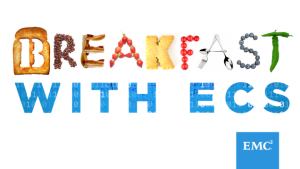Welcome to another edition of Breakfast with ECS, a series where we take a look at issues related to cloud storage and ECS (Elastic Cloud Storage), EMC’s cloud-scale storage platform.
 When Centera was introduced in 2002, it promised long term storage of a company’s archives with an architecture that completely separated the application access method from the storage infrastructure. From the beginning, EMC has always promised to maintain the Centera data, the APIs that are used to access it, and the applications that have integrated to those APIs, with the full knowledge that the lifecycle of the Centera data would exceed the lifecycle of any individual HW or SW platform. The Centera SW architecture has fulfilled this promise across multiple hardware generations and across multiple disk drive variants, and with ECS 2.2, the promise is being extended even across SW architectures.
When Centera was introduced in 2002, it promised long term storage of a company’s archives with an architecture that completely separated the application access method from the storage infrastructure. From the beginning, EMC has always promised to maintain the Centera data, the APIs that are used to access it, and the applications that have integrated to those APIs, with the full knowledge that the lifecycle of the Centera data would exceed the lifecycle of any individual HW or SW platform. The Centera SW architecture has fulfilled this promise across multiple hardware generations and across multiple disk drive variants, and with ECS 2.2, the promise is being extended even across SW architectures.
Why a new architecture?
The state of the industry has changed dramatically from when Centera was originally designed and built. Scale-out, distributed storage accessed via an IP network is no longer a novel concept, and increases in network speeds, CPU power, disk density, and memory sizes mean that the Centera model of a small number of disks per node is no longer economically feasible.
ECS is a new software architecture which was designed from the ground up to meet the needs of the modern data center, and with the ECS 2.2 release, it not only has full support for the Centera API, it has built in capabilities to automatically index and migrate content from a Centera cluster to the ECS, all in a non-disruptive fashion, maintaining full application access throughout the process.
But ECS does far more than just support the Centera use cases, ECS adds additional capabilities and efficiencies to the storage of Centera data and can even apply these to enhance the value of existing Centera data, as well as newly written data. These capabilities include:
- Erasure coding protection for all data, including clips, in addition to a greater variety of choice in the protection scheme to best meet the needs of the individual situation. ECS can protect data with 20% or 33% overhead and can apply this protection equally for large and small objects, all the way down to 4 node systems, for far better storage efficiencies than Centera.
- Protection against multiple disk failures. While Centera offered protection only against single disk failures, ECS protects against the simultaneous failure of 2 disks (20% overhead) or 4 disks (33% overhead).
- With the introduction of Data at Rest Encryption in ECS 2.2, ECS can automatically and transparently encrypt data before storing it, adding an additional level of protection for your most sensitive data.
- ECS provides site failure protection for less than 2x the original data size in a three or more site environment, unlike Centera which would need minimally 2.3x (4x if using mirroring) data storage for a similar level of protection.
- ECS offers far denser configurations, with up to 60 drives per node, for far more economical data storage than Centera.
In addition, ECS preserves Centera’s compliance capabilities, including fixed retention periods and retention classes, allowing all Basic, GE, and CE+ data from Centera to be safely migrated to ECS.
Read the Top Reasons Handout on why you should choose EMC Elastic Cloud Storage (ECS) for archiving.
How do I move from Centera to ECS?
There are two ways to start leveraging the benefits of ECS for Centera customers – either by leveraging an external migration tool, of which there are several choices available now, or by leveraging the built-in transformation capabilities in ECS 2.2.
The transformation capabilities of ECS 2.2 fully automate the migration process – the Centera is added to the ECS cluster and the application directs its reads and writes to the ECS – the ECS enumerates the Centera, creates an ECS-based index for that content, migrates the content, then performs a final reconciliation to validate that all data has been correctly migrated. The entire process is fully automated, driven by ECS, and transparent to the application.
Of course, ECS is capable of supporting workloads far different than the typical Centera workload. ECS is suited for modern S3 or Swift based applications, for analytics workloads, for web-based application storage, for Internet of Things applications, and much more. ECS 2.2 brings the benefits of a modern software architecture to the existing Centera data while simultaneously supporting modern application workloads and allowing a single software/hardware environment to satisfy the full set of scalable storage needs.